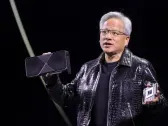Artificial Intelligence for Robots and Cars: A Breakthrough in Training Data
At the annual tech conference CES 2025 in Las Vegas, Nvidia CEO Jensen Huang unveiled a range of new products that have the potential to expand the company’s business. One of the key announcements was the introduction of artificial intelligence (AI) models designed to train robots and cars more efficiently.
Cosmos Foundation Models: A Game-Changer for Robotics and AI
Nvidia’s Cosmos foundation models can generate photo-realistic video, which can be used to train robots and self-driving cars at a significantly lower cost than traditional methods. These models use synthetic training data, similar to how large language models have helped chatbots generate natural language responses.
How Cosmos Works: A Text Description Generates Video
Users will be able to provide a text description that can be used to generate video of a world that obeys the laws of physics. This approach promises to be much cheaper than gathering data through methods such as putting cars on the road or having humans teach robots repetitive tasks.
Open License and Wide Adoption: The Future of Robotics and AI
Cosmos will be made available on an "open license," similar to Meta Platforms’ Llama 3 language models, which have become widely used in the tech industry. Nvidia’s goal is for Cosmos to have a significant impact on robotics and industrial AI, just as Llama 3 has done for enterprise AI.
"We really hope (Cosmos) will do for the world of robotics and industrial AI what Llama 3 has done for enterprise AI," Huang said.
Bank of America Analyst Weighs in: Challenges Ahead
However, Bank of America analyst Vivek Arya remains cautious about the potential impact of Nvidia’s robotics push on sales. "The challenge in our view is … making the products reliable enough, cheap enough and pervasive enough to spawn credible business models," Arya said.
Robotic Push: A Cool but Niche Opportunity?
Arya notes that while the robotics push has potential, it remains to be seen whether it will significantly boost Nvidia’s sales. "From that perspective, robotics could remain another cool but niche opportunity such as metaverse or autonomous cars."
New Gaming Chips: The RTX 50 Series
Huang also unveiled new gaming chips that use Nvidia’s Blackwell AI technology, which has contributed to its success in data centers. The RTX 50 series aims to give video games movie-like graphics, especially in the area of shaders.
Shaders can help images look more realistic by adding imperfections and fingerprint smudges, as seen on a ceramic teapot. The new chips can also help game developers generate more accurate human faces, an area where players are apt to notice even slightly unrealistic features.
Pricing and Availability: A Range of Options
The new gaming chips will range in price from $549 to $1,999, with top models arriving on January 30 and lower-tier models coming in February. Ben Bajarin, chief executive of technology consultancy Creative Strategies, believes the new gaming chips should help boost Nvidia sales in the short term.
Project DIGITS: A Desktop Computer for Programmers
Huang also showed off Project DIGITS, a desktop computer designed for computer programmers rather than regular consumers. The $3,000 computer will run an Nvidia operating system based on Linux and feature the same chip at the heart of the company’s data center offerings, paired with a central processor built with help from Taiwan’s MediaTek.
Smaller Package for Software Developers: Quick AI Testing
The chips will come in a smaller package that can be used by individual software developers to test their AI systems quickly. The desktop will be available in March.
Nvidia and Toyota Partnership: Advanced Driver Assistance
Nvidia also announced a partnership with Japan’s Toyota Motor, which will use its Orin chips and automotive operating system to power advanced driver assistance in several models. The details of the models were not disclosed.
Automotive Hardware and Software Revenue: $5 Billion by 2026
Huang expects automotive hardware and software revenue of $5 billion in fiscal 2026, up from an expected $4 billion this year.
CES 2025: A Platform for Innovation
The annual tech conference CES runs from January 7-10. Nvidia’s stock closed at a record high of $149.43 on Monday, bringing its valuation to $3.66 trillion and making it the world’s second-most valuable listed company behind Apple.
References
- This article is based on reporting by Max Cherney and Stephen Nellis in San Francisco.
- Editing by Edwina Gibbs.

